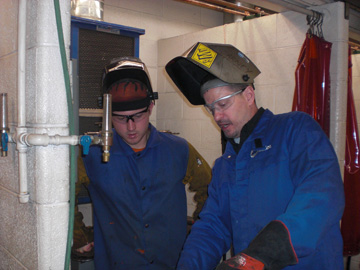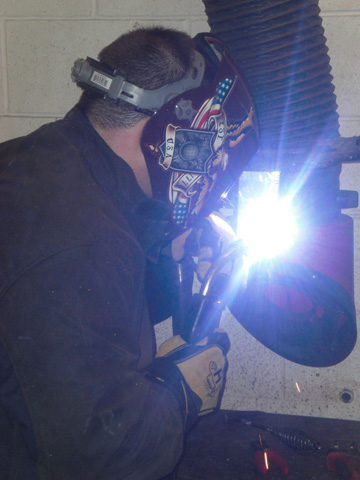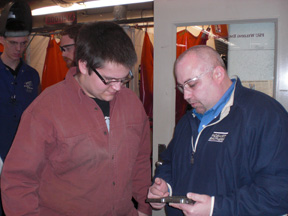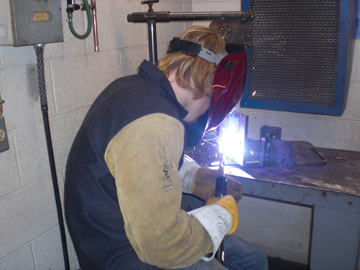Welding Program, Industry Support Helps Prepare Students for Careers
Ferris State University (FSU) is in the business of producing welding engineering technology graduates — and not just any ordinary ones. They are training students to enter emerging markets and assimilate their knowledge to oversee the many welding technologies they’ll find there. Trends in the automotive, energy, heavy equipment manufacturing and welding equipment industries are no mystery to these students. That’s just one of the reasons the school has such a high demand for graduates and also why they boast a 95-plus percent job placement for those leaving with a bachelor’s degree from FSU’s welding engineering technology program.
The Big Rapids, Mich.-based welding program has been around since 1955 and in that time has evolved from a one year certificate skill training to a Bachelor of Science degree that teaches process selection, non-destructive testing, welding procedure development and equipment specification. Students also study automation, weldment design, welding metallurgy and project management, and they learn how to weld using the gas tungsten arc welding (GTAW), gas metal arc welding (GMAW) processes, stick welding (SMAW) and more.

discusses welding technique with student, Jeremy Brewster
during a recent lab.
In addition to the guidance of their professors, students have the opportunity to meet regularly with industry professionals to help keep them apprised of the welding technologies and job opportunities available in the market place. Recently, as Hobart Brothers and MAXAL representatives, we had the chance to talk about opportunities with our company and the markets we serve, and to provide students with insight into developments in filler metal technology. Hobart Brothers has employed many Ferris State University graduates over the years and, as with many other companies, continues to maintain strong bonds with the program and also provide instructors with technical support.
Hobart Brothers and MAXAL are also among several companies that provide filler metal and equipment donations that help keep the program going. We were recently able to give FSU a large donation of SMAW electrodes and tubular wires, including metal-cored and flux-cored wires, along with aluminum GMAW and GTAW wire, and to help guide the students in their proper usage. We spent the day working in the labs with students and also conducted a seminar on metal-cored wires and on aluminum filler metals.
“We appreciate and encourage the support that all the welding equipment and filler metal manufacturers provide us,” says William England, technical instructor. “Our students really benefit from it, and that’s what’s important.”
The program … yesterday and today
The welding department at FSU offered a certificate program to its students from its inception until the 1970s when it established an associate degree program. It then expanded the curriculum by graduating its first four-year bachelor’s degree recipients in 1986. Professor Kenneth Kuk joined the staff in 1985 to start the Bachelor of Science program and has served as the patriarch of it since, teaching all of the Hobart Brothers welding engineers who have graduated with the four-year degree, as well as fellow instructors, William England and Jeff Carney, associate professor and program coordinator, who has been with the department since 1996.
Today, the university has what England calls a true “two plus two” welding program, which is also ETAC/ABET accredited. The resulting degrees are an Associate in Applied Science in Welding Technology and a Bachelor of Science in Welding Engineering Technology.
“Whereas an associate degree at a community college is often focused on meeting the needs of that

demonstrates welding vertical-up with metal-cored
wire.
region and preparing students to go right in the workforce, ours is designed to build into the bachelor’s degree,” he explains. “Our students can leave the program after two years and find gainful employment or they can build on that foundation for another two years and become a welding engineer.”
England estimates that approximately 60 percent of students continue on for their bachelor’s degree.
For the first two years, students learn to master oxy-acetylene, SMAW, GTAW and GMAW processes, as well as soldering, brazing, and plasma cutting, completing coursework that consists of both lectures and hands-on labs. Labs are three hours a day, four days a week.
To show the competency of their skills during the second semester of their sophomore year, students are required to complete a capstone project. They design and fabricate projects ranging from dog carriers and syrup cookers to wood stoves, boiler systems and log splitters — the choice is theirs. Or they can opt to complete a project needed by someone in the community.
Those students who are accepted into the competitive Bachelor of Science program spend their junior and senior years studying and applying themselves to the engineering technology side of welding, including weldment design and automation. They culminate their knowledge, as in their sophomore year, with a capstone project that incorporates a “cradle to grave” concept, including the design, engineering, fabrication, testing and management of a project from the ground up, using all the knowledge they have amassed from their curriculum.
In addition to the design and welding instruction, students also have the opportunity to use the department’s testing equipment to gauge their progress. The labs contain tensile and bend weld-testing equipment, and there is also a nondestructive testing lab where the students can make assessments. The space, which the school renovated in recent years, also serves as a study and gathering area for students.
Benefits of the FSU approach
One of the first things that’s immediately noticeable when visiting the welding laboratories at FSU isn’t just the noise or busyness of them (although there is plenty of both), but rather it’s the focus and independence of the students during their labs.
According to Carney, that autonomy is essential for the students to grow their skills.
“There’s a lot of trial and error to what they’re doing,” he explains. “It’s all about cause and effect. The students refine their skills by learning how to look at a weld, determine what might be wrong with it and how to fix it. We help them along the way, of course, but the process of learning how welding works is absolutely necessary for them to become proficient welding engineers.”

a completed weld and provides feedback to student, Keith
Zebell.
England expands on that philosophy, adding, “FSU is focused on producing plant level welding engineers. Here students develop the ability to think critically and troubleshoot, and they have the hands-on experience to back up the theories they learn.”
To that point, in the first two years of study, students are given a set amount of small projects, typically 18, to complete during a semester. The projects involve weld preparation and completing various types of welds for which each student must determine and refine the welding parameters. Welding instructors, like Dave Murray, associate professor, are always on hand to help. Murray has been with the program since 1981 and during our visit was seen moving throughout the lab, working side by side with students to consult with them on everything from the placement of welds on their capstone projects to testing welds and prepping materials.
Another part of refining student skills is to incorporate real world applications in the curriculum, including designing weldments for various industries and determining the financial ramifications of them. Such training becomes especially important for third and fourth year students, says Jeff Hardesty, assistant professor, when they begin to focus on welding automation.
“Our goal isn’t just to teach students to be proficient programmers,” he explains, “But more importantly, we teach them how to spec out and design the robotic cells and fixtures, troubleshoot and be able to put automation into production in the real world. They need to be able to produce good welds, and that might involve knowing when and how to seam track or creating a certain fixture for the application.”
Hardesty adds that learning how to deal with different materials and filler metals is also essential for students to apply their knowledge in the real world. They learn about metal-cored wires and flux-cored wires, for example, including the best applications for each and how to set the proper welding parameters for them.
Where to next?
All students enrolled in the bachelor’s degree program are required to complete an internship between their junior and senior year. The internships take place at welding equipment or filler metal manufacturers, and also manufacturers throughout the heavy equipment, automotive and energy sectors. About half of those internships, according to Hardesty, lead to full-time employment with the company after graduation.
Hobart Brothers is an active participant in the internship program with FSU and continues to hire interns for full-time employment, including two recent graduates, Robert Fox and Blain Guy.

Student, Greg Jonker, practices his welds. Lab work in FSU’s
welding technology program consists of multiple projects that
students must complete each semester and test for quality.
The school has a career placement center that assists in locating these internships, as well as well as placing graduates in companies in emerging markets. Counselors keep in close contact with companies, and members of the department say they receive calls daily, if not multiple times a day, from companies looking to recruit welding engineers.
Because industry demands change, instructors in the welding engineering technology program at FSU know that their curriculum and focus will also have to change if they are to keep their graduates at the leading edge.
“This program is an evolving concept,” says England. “We are still developing and we always will be. It’s what sets this program apart from the rest.”



